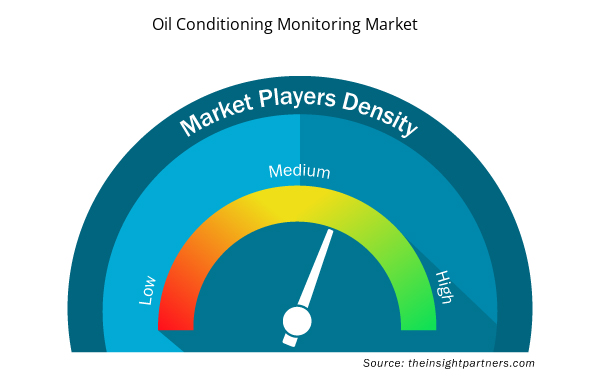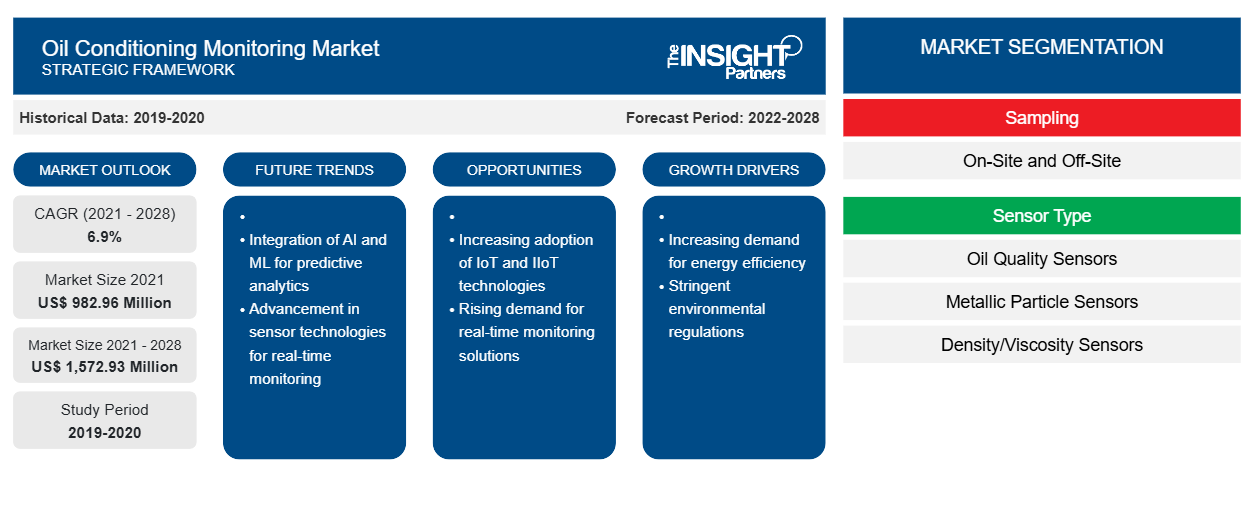オイルコンディショニングモニタリング市場は、2021年の9億8,296万米ドルから2028年には15億7,293万米ドルに成長すると予想されており、2021年から2028年にかけて6.9%のCAGRで成長すると予測されています。
産業用 IoT の使用により、効率性の向上から安全リスクの低減、出張の減少まで、石油・ガス産業の環境への影響が大幅に軽減されています。石油・ガス企業は、エネルギーの節約、石油流出やその他の大惨事の回避、炭素排出量の削減に役立つことから、IIoT に注目しています。IIoT は、エネルギーとリソースの消費を監視することもできます。インテリジェント テクノロジーは、運用から消費者とのやり取りまで、石油・ガス サプライ チェーンのほぼすべての領域に影響を及ぼしています。サプライ チェーン内のスマート デバイスは、石油・ガス業界に、コモディティ化された世界で競争する機会と、旧来のセクターを迅速に近代化するチャンスを与えています。さらに、IoT (モノのインターネット) には、データ収集方法を大幅に改善する可能性が秘められています。石油・ガス セクターは、他のどの業界よりも効率性と精度を重視しています。
要件に合わせてレポートをカスタマイズする
このレポートの一部、国レベルの分析、Excelデータパックなど、あらゆるレポートを無料でカスタマイズできます。また、スタートアップや大学向けのお得なオファーや割引もご利用いただけます。
- このレポートの主要な市場動向を入手してください。この無料サンプルには、市場動向から見積もりや予測に至るまでのデータ分析が含まれます。
COVID-19パンデミックによるオイルコンディショニングモニタリング市場への影響
COVID-19パンデミックは世界中の多くの業界を揺るがしました。ロックダウンは製造業やITを含む様々な業界の業務を妨げました。しかし、日用消費財(FMCG)や製薬などの重要な産業は業務を継続しなければなりませんでした。石油部門は過去12か月で3度目の価格暴落に見舞われています。業界は最初の2回のショックから回復し、通常通りのビジネスを再開しました。しかし今回は状況が異なります。現在の状況には、供給ショック、歴史的に低い需要、世界的な人道的大惨事が含まれています。さらに、この部門の財務的および構造的な健全性は過去の危機よりも悪化しています。収益の低迷は、シェールガスの導入、過剰生産、資本規律の欠如を無視した自由主義的な金融市場に起因するとされています。価格が30年ぶりの安値に近づき、世論の圧力が高まる中、リーダーたちは変化は避けられないことを認識しました。COVID-19の問題は深刻化しています。そのため、COVID-19の流行とその影響は、オイルコンディショニングモニタリング市場に大混乱をもたらしています。
オイルコンディショニングモニタリング市場の洞察
世界中で発電需要が高まり、オイルコンディショニングモニタリング市場の成長を促進
世界中のエネルギー消費量は今後数年間で増加すると予想されており、世界人口の増加と中国やインドなどの発展途上国の経済および産業の成長により、2035年までに年間使用量は約778エタジュールに達すると予想されています。産業機械やその他の装置の設計者と製造業者は、加熱と冷却の損失を減らし、熱伝達を改善し、電気モーターを改善することで、製品のエネルギー効率を向上させる方法を常に模索しています。原子力は、信頼性の高いベースロード電力の必要性や地球規模の気候変動の脅威などの要因により、引き続き必要です。さらに、原子力は、ほぼ炭素フリーの電力を大規模に供給できる唯一の電源であるため、エネルギー戦略の重要な要素です。世界の電力の約20%、低炭素エネルギーの60%以上を原子力で生産しています。原子力発電所は、増加する電力需要を満たすためのエネルギー源として浮上してきました。原子力発電所は、核燃料サイクルの問題に直面しており、最終的には、そのライフサイクルの一環として、または自然災害や人為的災害が発生した場合に、そのような施設の廃止措置が予定されており、施設内の油状態監視の需要が高まっています。
サンプリングに基づく市場分析
サンプリングに基づいて、世界のオイルコンディショニングモニタリング市場は、オンサイトとオフサイトに分割されています。2020年には、オフサイトセグメントが主導し、オイルコンディショニングモニタリングセグメントが市場で大きなシェアを占めました。
センサータイプ別の市場分析
センサーの種類に基づいて、オイルコンディショニングモニタリング市場は、オイル品質センサー、金属粒子センサー、密度/粘度センサーに分類されます。2020年には、オイル品質センサーセグメントが市場で最大のシェアを占め、オイルコンディショニングモニタリングセグメントがリードしました。
製品ベースの市場分析
製品に基づいて、オイルコンディショニング監視市場は、タービン、コンプレッサー、エンジン、ギアシステム、油圧システムに分類されます。2020年には、タービンセグメントが主導し、オイルコンディショニング監視セグメントが市場で最大のシェアを占めました。
測定に基づく市場洞察
測定に基づいて、オイルコンディショニングモニタリング市場は、温度、圧力、密度、粘度、誘電率、TAN / TBN、水希釈、燃料希釈、すす、摩耗粒子に分類されます。2020年には、粘度セグメントが主導し、オイルコンディショニングモニタリングセグメントが市場で最大のシェアを占めました。
業界別の市場分析
業界別に見ると、オイルコンディショニングモニタリング市場は、輸送、工業、石油・ガス、エネルギー・電力、鉱業に区分されています。2020年には、輸送部門が主導し、オイルコンディショニングモニタリング部門が市場で最大のシェアを占めました。
オイルコンディショニングモニタリング市場で活動する企業は、合併、買収、市場イニシアチブなどの戦略を採用して、市場での地位を維持しています。主要企業によるいくつかの開発を以下に示します。
- 2020 年 8 月、ALS はロチェスターを拠点とする高度なオンライン オイル状態監視 (OCM) ソリューションの開発会社である Poseidon Systems との戦略的コラボレーションを開始しました。両社は、Poseidon Systems の受賞歴のあるオンライン OCM テクノロジーと ALS のオイル分析およびテストの経験を組み合わせることで OCM を変革するという共通の目標を持っています。
- プロセス機器の信頼性を向上させ、潤滑油の寿命を延ばす特殊濾過製品の世界的メーカーである Des-Case Corporation は、2020 年 8 月に、産業用潤滑資産向けの新しいリモート診断モニタリング サブスクリプション プランの開始を発表しました。これにより、重要な資産内の潤滑油の状態、清浄度、湿度がリアルタイムでモニタリングされ、顧客は安心して利用できるようになります。
オイルコンディショニングモニタリング市場の地域別洞察
予測期間を通じてオイルコンディショニングモニタリング市場に影響を与える地域的な傾向と要因は、Insight Partners のアナリストによって徹底的に説明されています。このセクションでは、北米、ヨーロッパ、アジア太平洋、中東、アフリカ、南米、中米にわたるオイルコンディショニングモニタリング市場のセグメントと地理についても説明します。

- オイルコンディショニングモニタリング市場の地域別データを入手
オイルコンディショニングモニタリング市場レポートの範囲
| レポート属性 | 詳細 |
|---|---|
| 2021年の市場規模 | 9億8,296万米ドル |
| 2028年までの市場規模 | 15億7,293万米ドル |
| 世界のCAGR(2021年~2028年) | 6.9% |
| 履歴データ | 2019-2020 |
| 予測期間 | 2022-2028 |
| 対象セグメント | サンプリングによる
|
| 対象地域と国 | 北米
|
| 市場リーダーと主要企業プロフィール |
|
オイルコンディショニングモニタリング市場のプレーヤー密度:ビジネスダイナミクスへの影響を理解する
オイルコンディショニングモニタリング市場は、消費者の嗜好の変化、技術の進歩、製品の利点に対する認識の高まりなどの要因により、エンドユーザーの需要が高まり、急速に成長しています。需要が高まるにつれて、企業は提供を拡大し、消費者のニーズを満たすために革新し、新たなトレンドを活用し、市場の成長をさらに促進しています。
市場プレーヤー密度とは、特定の市場または業界内で活動している企業または会社の分布を指します。これは、特定の市場スペースに、その市場規模または総市場価値に対してどれだけの競合相手 (市場プレーヤー) が存在するかを示します。
オイルコンディショニングモニタリング市場で事業を展開している主要企業は次のとおりです。
- CMテクノロジーズGmbH
- デ・ケース、
- ハイダックテクノロジーリミテッド
- インターテックグループ
- ポセイドンシステムズ
免責事項:上記の企業は、特定の順序でランク付けされていません。

- オイルコンディショニングモニタリング市場のトップキープレーヤーの概要を入手
世界のオイルコンディショニングモニタリング市場は、以下のようにセグメント化されています。
サンプリングによる
- 現場で
- オフサイト
センサータイプ別
- オイル品質センサー
- 金属粒子センサー
- 密度/粘度センサー
製品別
- タービン
- コンプレッサー
- エンジン
- ギアシステム
- 油圧システム
測定による
- 温度
- プレッシャー
- 密度
- 粘度
- 誘電
- TAN/TBN
- 水希釈
- 燃料希釈
- すす
- 摩耗粒子
業界別
- 交通機関
- 産業
- 石油・ガス
- エネルギーと電力
- 鉱業
地理別
- 北米
- 私たち
- カナダ
- メキシコ
- ヨーロッパ
- フランス
- ドイツ
- イタリア
- 英国
- ロシア
- その他のヨーロッパ
- アジア太平洋(APAC)
- 中国
- インド
- 韓国
- 日本
- オーストラリア
- その他のアジア太平洋地域
- 中東・アフリカ(MEA)
- 南アフリカ
- サウジアラビア
- アラブ首長国連邦
- MEAの残り
- 南アメリカ(SAM)
- ブラジル
- アルゼンチン
- 残りのSAM
企業プロフィール
- CMテクノロジーズ株式会社
- デ・ケース
- ハイダックテクノロジーリミテッド
- インターテックグループ
- ポセイドンシステムズ
- レオニクスグループ
- SGS SA
- スペシャルオイルフィールドサービス株式会社
- TANデルタシステムズリミテッド
- ベリタス石油サービス
- 過去2年間の分析、基準年、CAGRによる予測(7年間)
- PEST分析とSWOT分析
- 市場規模価値/数量 - 世界、地域、国
- 業界と競争環境
- Excel データセット



Report Coverage
Revenue forecast, Company Analysis, Industry landscape, Growth factors, and Trends

Segment Covered
This text is related
to segments covered.

Regional Scope
North America, Europe, Asia Pacific, Middle East & Africa, South & Central America

Country Scope
This text is related
to country scope.
よくある質問
The major companies in oil condition monitoring market includes Intertek Group Plc.; SGS SA; Hydac Technology Limited; Veritas Petroleum Services; and Des-Case.
The major industries in oil condition monitoring includes transportation, power generation, industrial, mining, and oil &gas. Oil and gas is contributing a substantial revenue to the market growth.
In 2020, North America led the market with a substantial revenue share, followed by APAC and Europe. North America is a prospective market for oil monitoring equipment manufacturers.
The study of lubricating oils in use helps in lowering operating costs, reducing downtimes, increasing plant and equipment lives, and making effective maintenance plans. Lubricating oil analysis is also being used to check the condition of engines and other machinery. It is used to lubricate most lubricated mechanical systems, such as engines, gear gearboxes, hydraulics, and the like, and has a wide range of applications in industries such as construction, power production, and transportation, including aircraft, fleet operations, and public transit. In addition, under fault circumstances, many additional changes may occur in oils, such as dilution by fuels or contamination by water or anti-freeze. As a result, efficient oil monitoring aids in the provision of cost-effective services in a variety of industrial surroundings.
The global oil conditioning monitoring market was dominated by the oil quality sensors during the forecast period, which accounted for 61.0% in 2020. Oil Quality Sensors conditioning monitoring are traditional equipment that are used majorly for oil quality detection.
The market opportunity lies in developing countries. Developing countries have become a hub of opportunity for various markets, including oil conditioning monitoring market. In order to improve the overall infrastructure, government authorities in these countries are planning and investing huge amount in machines and technologies.
Trends and growth analysis reports related to Electronics and Semiconductor : READ MORE..
The List of Companies - Oil Conditioning Monitoring Market
- CM Technologies GmbH,
- Des-Case,
- Hydac Technology Limited
- Intertek Group Plc.
- Poseidon Systems
- Rheonics Group
- SGS SA
- Special Oilfield Services Co. LLC
- TAN Delta Systems Limited
- Veritas Petroleum Services
The Insight Partners performs research in 4 major stages: Data Collection & Secondary Research, Primary Research, Data Analysis and Data Triangulation & Final Review.
- Data Collection and Secondary Research:
As a market research and consulting firm operating from a decade, we have published and advised several client across the globe. First step for any study will start with an assessment of currently available data and insights from existing reports. Further, historical and current market information is collected from Investor Presentations, Annual Reports, SEC Filings, etc., and other information related to company’s performance and market positioning are gathered from Paid Databases (Factiva, Hoovers, and Reuters) and various other publications available in public domain.
Several associations trade associates, technical forums, institutes, societies and organization are accessed to gain technical as well as market related insights through their publications such as research papers, blogs and press releases related to the studies are referred to get cues about the market. Further, white papers, journals, magazines, and other news articles published in last 3 years are scrutinized and analyzed to understand the current market trends.
- Primary Research:
The primarily interview analysis comprise of data obtained from industry participants interview and answers to survey questions gathered by in-house primary team.
For primary research, interviews are conducted with industry experts/CEOs/Marketing Managers/VPs/Subject Matter Experts from both demand and supply side to get a 360-degree view of the market. The primary team conducts several interviews based on the complexity of the markets to understand the various market trends and dynamics which makes research more credible and precise.
A typical research interview fulfils the following functions:
- Provides first-hand information on the market size, market trends, growth trends, competitive landscape, and outlook
- Validates and strengthens in-house secondary research findings
- Develops the analysis team’s expertise and market understanding
Primary research involves email interactions and telephone interviews for each market, category, segment, and sub-segment across geographies. The participants who typically take part in such a process include, but are not limited to:
- Industry participants: VPs, business development managers, market intelligence managers and national sales managers
- Outside experts: Valuation experts, research analysts and key opinion leaders specializing in the electronics and semiconductor industry.
Below is the breakup of our primary respondents by company, designation, and region:

Once we receive the confirmation from primary research sources or primary respondents, we finalize the base year market estimation and forecast the data as per the macroeconomic and microeconomic factors assessed during data collection.
- Data Analysis:
Once data is validated through both secondary as well as primary respondents, we finalize the market estimations by hypothesis formulation and factor analysis at regional and country level.
- Macro-Economic Factor Analysis:
We analyse macroeconomic indicators such the gross domestic product (GDP), increase in the demand for goods and services across industries, technological advancement, regional economic growth, governmental policies, the influence of COVID-19, PEST analysis, and other aspects. This analysis aids in setting benchmarks for various nations/regions and approximating market splits. Additionally, the general trend of the aforementioned components aid in determining the market's development possibilities.
- Country Level Data:
Various factors that are especially aligned to the country are taken into account to determine the market size for a certain area and country, including the presence of vendors, such as headquarters and offices, the country's GDP, demand patterns, and industry growth. To comprehend the market dynamics for the nation, a number of growth variables, inhibitors, application areas, and current market trends are researched. The aforementioned elements aid in determining the country's overall market's growth potential.
- Company Profile:
The “Table of Contents” is formulated by listing and analyzing more than 25 - 30 companies operating in the market ecosystem across geographies. However, we profile only 10 companies as a standard practice in our syndicate reports. These 10 companies comprise leading, emerging, and regional players. Nonetheless, our analysis is not restricted to the 10 listed companies, we also analyze other companies present in the market to develop a holistic view and understand the prevailing trends. The “Company Profiles” section in the report covers key facts, business description, products & services, financial information, SWOT analysis, and key developments. The financial information presented is extracted from the annual reports and official documents of the publicly listed companies. Upon collecting the information for the sections of respective companies, we verify them via various primary sources and then compile the data in respective company profiles. The company level information helps us in deriving the base number as well as in forecasting the market size.
- Developing Base Number:
Aggregation of sales statistics (2020-2022) and macro-economic factor, and other secondary and primary research insights are utilized to arrive at base number and related market shares for 2022. The data gaps are identified in this step and relevant market data is analyzed, collected from paid primary interviews or databases. On finalizing the base year market size, forecasts are developed on the basis of macro-economic, industry and market growth factors and company level analysis.
- Data Triangulation and Final Review:
The market findings and base year market size calculations are validated from supply as well as demand side. Demand side validations are based on macro-economic factor analysis and benchmarks for respective regions and countries. In case of supply side validations, revenues of major companies are estimated (in case not available) based on industry benchmark, approximate number of employees, product portfolio, and primary interviews revenues are gathered. Further revenue from target product/service segment is assessed to avoid overshooting of market statistics. In case of heavy deviations between supply and demand side values, all thes steps are repeated to achieve synchronization.
We follow an iterative model, wherein we share our research findings with Subject Matter Experts (SME’s) and Key Opinion Leaders (KOLs) until consensus view of the market is not formulated – this model negates any drastic deviation in the opinions of experts. Only validated and universally acceptable research findings are quoted in our reports.
We have important check points that we use to validate our research findings – which we call – data triangulation, where we validate the information, we generate from secondary sources with primary interviews and then we re-validate with our internal data bases and Subject matter experts. This comprehensive model enables us to deliver high quality, reliable data in shortest possible time.


 このレポートの無料サンプルを入手する
このレポートの無料サンプルを入手する